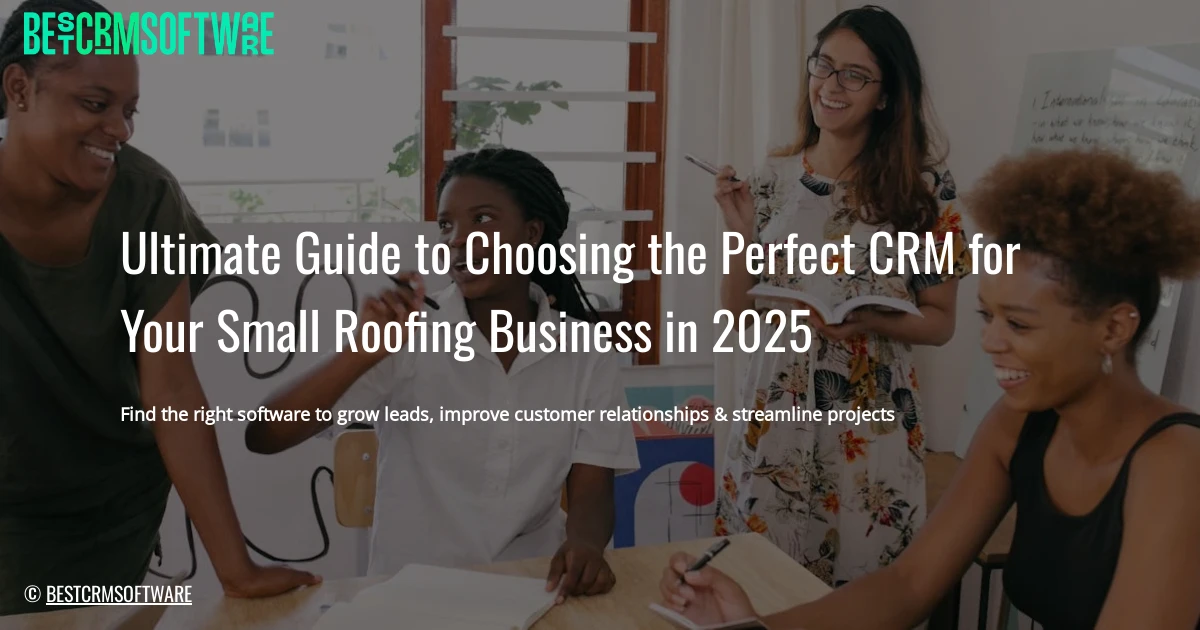Find the right software to grow leads, improve customer relationships & streamline projects
Introduction: The CRM Revolution in Roofing
The roofing industry is on the verge of a significant transformation, driven by evolving customer expectations, advancements in technology, and the emergence of new business models. As we head into 2025, understanding the changing landscape becomes paramount for small roofing businesses seeking to thrive.
Understanding the Roofing Industry Landscape in 2025:
- Increasing Competition: The industry will become increasingly competitive, with more players vying for a limited pool of customers. This will make it crucial for businesses to differentiate themselves and provide superior customer service.
- Changing Demographics: Aging populations and evolving homeownership trends will present both opportunities and challenges for roofing companies.
- Climate Change: The effects of climate change, including extreme weather events, will lead to an increase in roof repairs and replacements, creating new demand but also posing operational complexities.
The Evolving Needs of Roofing Customers:
- Transparency & Accessibility: Customers today expect a highly transparent and accessible experience. They demand real-time communication, online scheduling, and readily available information on projects, costs, and timelines.
- Personalized Service: Customers want tailored solutions that meet their unique needs, whether it’s addressing specific roof issues, choosing materials, or scheduling appointments based on individual preferences.
- Mobile First Experience: As technology permeates everyday life, customers increasingly prefer mobile-first experiences, expecting access to information, communication, and services on their smartphones and tablets.
How Technology is Reshaping Roofing Businesses:
- Automation & Efficiency: Artificial intelligence (AI) and automation are transforming processes like quoting, scheduling, and customer communication, increasing efficiency and productivity.
- Data-Driven Insights: Businesses are using data analytics to gain insights into customer behavior, market trends, and operational performance, enabling smarter decision-making and targeted marketing.
- Improved Customer Engagement: Technology facilitates improved communication with customers, from personalized emails to interactive dashboards, enhancing customer satisfaction and loyalty.
These trends collectively emphasize the need for roofing businesses to adopt new technologies, particularly customer relationship management (CRM) solutions, to stay ahead of the curve and effectively navigate the changing market. In the upcoming sections, we’ll explore how CRM can be the key to unlocking success for your small roofing business in 2025 and beyond.
CRM 101 for Roofing Businesses
What is a CRM and How Does it Work?
A CRM, or Customer Relationship Management system, is essentially a digital hub for all your customer interactions. Imagine it as a comprehensive database that keeps track of everything from initial inquiries to completed projects, customer details, communication history, and more. This information is then organized and accessible through an easy-to-use interface, making it incredibly helpful for managing customer relationships, tracking sales progress, and ultimately, growing your business.
Here’s how it works:
- Capture and Store Data: A CRM captures and stores every touchpoint you have with a customer, be it an initial phone call, website form submission, email correspondence, or even a social media message.
- Automate Processes: By organizing information, a CRM can automate repetitive tasks like sending out welcome emails, scheduling follow-up calls, or sending project updates.
- Provide Insights: This centralized database of customer information gives you invaluable insights. You can analyze customer trends, identify sales patterns, and understand what motivates your clients, leading to improved strategies and targeted marketing.
- Streamline Communication: All interactions with a customer are accessible from the same platform, allowing for smooth communication flow and preventing missed information or repeated efforts.
Benefits of Using a CRM for Roofing Companies
For roofing businesses specifically, a CRM brings several benefits that can dramatically impact your success:
- Improved Customer Retention: A CRM allows you to build stronger relationships by understanding customer needs and preferences, ensuring timely follow-ups and proactive service. This leads to increased customer loyalty and reduced churn.
- Enhanced Sales Efficiency: Tracking leads, nurturing them through the sales funnel, and closing deals efficiently is a breeze with a CRM. You can visualize your pipeline, identify bottlenecks, and streamline your sales processes.
- Streamlined Project Management: From project initiation to completion, a CRM can track progress, assign tasks, manage communication with clients, and even help manage subcontractors. This enhances project coordination and minimizes delays.
- Simplified Marketing and Outreach: With valuable customer data at your fingertips, you can segment your audience and target specific campaigns. This allows for efficient marketing spend and targeted messaging that resonates with your audience.
- Reduced Administrative Overhead: Automating repetitive tasks like email sequences and sending invoices frees up your team’s valuable time to focus on higher-level strategic initiatives.
Key Features to Look for in a Roofing CRM
Not all CRMs are created equal. To ensure you choose the best fit for your roofing business, look for these essential features:
- Customization Options: You need a CRM that allows you to adapt workflows and reporting to suit the specific needs of your roofing business.
- Mobile Accessibility: Be able to access your CRM anytime, anywhere from your phone or tablet for greater flexibility.
- Integration with Other Tools: Seamlessly integrate your CRM with other essential tools you use, such as your accounting software, marketing automation platform, or project management tool.
- Strong Reporting and Analytics: Get actionable insights through customizable reports that provide clarity into customer behavior, sales performance, and overall business trends.
- User-friendly Interface: Your CRM should be intuitive and easy to navigate, even for team members who aren’t tech-savvy.
The right CRM can transform your roofing business, leading to more leads, improved customer relationships, and greater efficiency. Choosing the right tool will empower you to overcome challenges, drive growth, and establish your business as a trusted leader in the roofing industry.

© Jopwell
Addressing Core Challenges with a CRM
Your roofing business thrives on strong relationships and efficient execution. A robust CRM can help you tackle common challenges and elevate your business operations. Let’s delve into how a CRM specifically addresses these key areas:
1. Lead Generation & Management:
- Centralized Hub: Instead of juggling spreadsheets and fragmented data, a CRM provides a central platform for managing all your leads. You’ll have a clear picture of each prospect, including their contact information, communication history, and their stage in the sales funnel.
- Streamlined Lead Acquisition: With features like automated email campaigns and form integrations, your CRM can effectively attract potential clients through various channels, like your website or social media.
- Intelligent Lead Scoring: By analyzing lead behavior and engagement, a CRM can score leads based on their likelihood of converting into paying customers. This helps you prioritize efforts and focus on high-value prospects.
2. Customer Relationship Building:
- Personalized Communication: Build lasting customer relationships by delivering tailored communications through personalized email templates, automated follow-ups, and birthday wishes.
- Enhanced Communication: CRM systems offer a single platform to manage all your communications with customers, including emails, phone calls, and notes. This ensures clear communication history and minimizes confusion.
- Customer Segmentation: Divide your client base into meaningful groups based on factors like purchase history, location, or needs. This allows you to tailor marketing and support efforts to each segment.
3. Project Management & Scheduling:
- Organized Project Tracking: Track every stage of each roofing project – from initial assessment to completion. Assign tasks, set deadlines, and monitor progress all within the CRM.
- Streamlined Communication: Collaborate seamlessly with your team on projects, ensure everyone stays informed, and minimize miscommunication.
- Efficient Scheduling: Schedule and track appointments, team meetings, and inspections, ensuring everyone involved has the information they need.
- Automated Reminders: Avoid missed appointments and deadlines with automated reminders for both your team and clients.
By addressing these key challenges, a CRM empowers your small roofing business to streamline operations, build lasting customer relationships, and ultimately, drive business growth.
Factors to Consider When Choosing a CRM
Choosing the right CRM can be the key to unlocking growth and efficiency for your small roofing business. However, with so many options available, the selection process can feel overwhelming. To make the best decision for your company’s future, it’s essential to consider the following factors:
1. Defining Your Specific Business Needs:
- What are your main pain points? Are you struggling to manage customer interactions, track leads effectively, or optimize scheduling? Identify the specific areas where a CRM can provide the most significant benefits for your team.
- What are your goals for using a CRM? Are you aiming to increase customer retention, improve lead conversion rates, or automate tasks to save time? Defining clear objectives will guide you toward a solution that aligns with your business strategy.
- Who will be using the CRM? Will it be your sales team, customer service representatives, project managers, or a combination of all? Understanding the user base ensures you choose a system with an intuitive interface and features that cater to their needs.
2. Budget Considerations for Small Roofing Businesses:
- Consider the cost per user and overall pricing structure. Some CRMs offer tiered plans based on the number of users or features, while others may offer a fixed monthly fee.
- Look for features that offer value for your specific needs. Avoid investing in features that are unnecessary or overly expensive for your current business size.
- Factor in the cost of implementation and training. While initial cost may seem low, the complexity of setup and training can significantly impact your overall investment. Look for systems with clear and concise onboarding processes.
3. Integration with Existing Software (Accounting, Marketing):
- Choose a CRM that integrates with your existing software. This ensures seamless data transfer between platforms, eliminating duplicate entries and saving valuable time.
- Check for pre-built integrations with accounting systems (QuickBooks, Xero) and marketing platforms (Mailchimp, Google Ads). These integrations can simplify processes and provide a holistic view of customer data.
- Ensure the CRM supports API integrations if your current systems are not listed as pre-built integrations. This allows for flexibility and customizability in data sharing across your various business tools.
4. Scalability and Future Growth Potential:
- Choose a CRM that can adapt to your changing business needs. Select a platform with scalability to support growth in customer base, team size, and complexity of operations.
- Consider cloud-based CRMs. These solutions offer greater flexibility, remote access, and scalability without significant IT infrastructure investments.
- Prioritize a CRM with strong support options. Reliable customer support, documentation, and community forums are essential as your business expands and you encounter new challenges.
By carefully considering these factors, you can narrow down your CRM choices and select a system that effectively supports the growth and efficiency of your small roofing business in 2025 and beyond.

© fauxels
Technical Aspects of Choosing a CRM
As a roofing business, you need a CRM solution that aligns with your technical needs and budget. Here are some crucial factors to consider:
1. Cloud-Based vs. On-Premise Solutions:
- Cloud-Based:
- Benefits: Access data from anywhere, anytime with an internet connection. Requires less initial investment, automatic updates, scalability for future growth.
- Downsides: Requires stable internet connectivity. Might have security concerns regarding data privacy.
- On-Premise:
- Benefits: Greater control over data storage and security. No dependency on internet connectivity.
- Downsides: Significant upfront cost for software, hardware, and maintenance. Limited accessibility compared to cloud solutions. Difficult to scale.
2. Understanding Different CRM Pricing Models:
- Subscription-Based:
- Benefits: Predictable monthly or annual cost. Pay only for the features you need. Often includes automatic updates and technical support.
- Downsides: Continuing recurring costs. You might face restrictions if you exceed the allotted users or data storage.
- One-Time Purchase:
- Benefits: No recurring payments. Complete ownership of the software.
- Downsides: Large upfront cost. You’ll need to pay for updates and technical support separately.
3. Importance of User-Friendly Interface and Experience:
- Simplicity and Ease of Use: Look for a CRM with an intuitive design and simple navigation. It should be easy for all users to learn and use, regardless of their tech skills.
- Customization: The CRM should offer the flexibility to adapt and customize the platform to your specific workflows and needs.
- Mobile Compatibility: Access to data and functionality from smartphones or tablets is essential for field-based employees.
- Training & Support: Consider the quality and availability of training resources and customer support offered by the CRM vendor.
Choosing the right CRM based on these technical aspects will streamline your operations, improve efficiency, and set your roofing business up for long-term success.
Top CRM Options for Small Roofing Businesses
Choosing the right CRM (Customer Relationship Management) software is crucial for any small roofing business looking to streamline operations, boost sales, and enhance customer satisfaction. Here’s a detailed comparison of three leading CRM providers specifically tailored to meet the needs of small roofing companies in 2025:
[CRM Provider 1] – Features, Pricing, Pros & Cons
Features:
- Lead Management: Efficient lead capture forms, automated follow-ups, and robust lead scoring for prioritization.
- Project Management: Assign tasks, track project milestones, and manage budgets within the CRM.
- Communication Tools: Built-in email marketing, SMS messaging, and a dedicated communication log for seamless interactions.
- Reporting and Analytics: Customizable dashboards and reports for insights into sales performance, customer engagement, and project progress.
- Mobile App: Access and manage crucial data on the go for greater team flexibility.
Pricing: Starting at $X per user per month, with scalable plans based on team size and desired features.
Pros:
- Comprehensive feature set: Covers essential functions for sales, marketing, and project management.
- User-friendly interface: Easy to navigate and adopt for teams with varying levels of technical expertise.
- Mobile-optimized: Access and manage CRM data from smartphones and tablets.
Cons:
- Limited customization: May require some workarounds for unique workflows or business processes.
- Steeper learning curve: Requires time and effort to master all features and functionality.
[CRM Provider 2] – Features, Pricing, Pros & Cons
Features:
- Focus on Customer Service: Features include ticket tracking, knowledge base management, and customer feedback tools.
- Integrations with Other Tools: Integrate with popular roofing software such as estimating tools, scheduling systems, and accounting programs.
- Advanced Automation: Automate tasks like lead assignment, email sequences, and scheduling for efficiency.
- Strong Customer Support: Responsive technical support team available via email, phone, and live chat.
Pricing: Plans start at $Y per user per month, with tiered plans offering increased features and customization options.
Pros:
- Streamlined customer service workflow: Facilitates efficient communication and problem resolution.
- Extensive integrations: Seamless connection with key roofing industry tools for a holistic view of operations.
- Excellent customer support: Dedicated assistance ensures a smooth transition and ongoing guidance.
Cons:
- May lack advanced sales and marketing capabilities: Focused primarily on customer service and support, which may not be ideal for all businesses.
- Higher upfront investment: Starting price point is more expensive compared to some alternatives.
[CRM Provider 3] – Features, Pricing, Pros & Cons
Features:
- Designed for Small Businesses: Simplified interface and focus on core functions relevant to small roofing companies.
- Targeted Lead Generation: Effective tools for capturing leads from specific sources like website forms or referrals.
- Personalized Marketing Campaigns: Targeted email marketing, social media campaigns, and automated outreach based on customer preferences.
- ** Affordable pricing:** Designed to be accessible for small businesses with limited budgets.
Pricing: Plans start at $Z per month for basic features, with add-on packages available for advanced functionality.
Pros:
- Intuitive interface: Simple and user-friendly, making it easy to adopt even for technology-challenged teams.
- Cost-effective: Offers a solid suite of features at a budget-friendly price point.
- Targeted marketing capabilities: Focus on capturing and nurturing qualified leads for increased conversion rates.
Cons:
- Limited integrations: Fewer pre-built integrations compared to other CRMs, requiring workarounds or custom integrations.
- Fewer advanced features: Focus on simplicity means some more sophisticated tools may not be included.
Next Steps:
After evaluating these CRM options, research and explore free trials to experience the features and interface firsthand. Consider your budget, team size, and specific business needs before making your final decision. Selecting the perfect CRM for your small roofing business in 2025 will lay the foundation for success by optimizing workflows, building stronger customer relationships, and maximizing growth opportunities.

© Andrea Piacquadio
Evaluating CRM Solutions Effectively
Choosing the right CRM for your small roofing business is a crucial decision that requires careful evaluation. To help you narrow down your options, here are three effective strategies:
1. Requesting Free Trials and Demos:
Don’t rely solely on marketing materials and sales pitches. Request free trials and demos of the CRM solutions you’re considering. This hands-on experience allows you to:
- Test the user interface and functionality: See how intuitive and user-friendly the platform is. Consider the ease of navigation, data input, and report generation.
- Assess the features: Determine if the CRM offers the specific features you need for your roofing business, like job scheduling, lead management, customer communication, and financial tracking.
- Experiment with integration: Check how seamlessly the CRM integrates with other tools you use, such as accounting software, email marketing platforms, and scheduling apps.
- Explore the mobile app (if applicable): Evaluate the mobile version’s user experience for managing tasks and accessing data on the go.
2. Leveraging Online Reviews and Testimonials:
Explore what other roofing businesses say about the CRM platforms you’re interested in. Utilize online resources like:
- G2: A platform that aggregates user reviews and provides detailed comparisons of CRM software.
- Capterra: Another website offering user reviews, ratings, and comparisons of different CRM systems.
- Software Advice: A directory and review platform with extensive insights into CRM software for small businesses.
- Industry forums and communities: Search for discussions about CRM solutions on roofing forums and online communities to get valuable first-hand feedback.
By reading reviews and testimonials, you can gain insights into the strengths and weaknesses of each CRM, and gather crucial information about their usability, performance, customer support, and overall value.
3. Seeking Recommendations from Industry Peers:
Connect with other roofing business owners and ask about their CRM experiences. This personal approach can offer valuable perspectives and insights that might not be found in online reviews.
- Network at industry events: Attend roofing conferences and tradeshows to connect with peers and gather recommendations.
- Join online groups and communities: Participate in online forums and groups dedicated to roofing businesses to exchange tips and feedback on CRM solutions.
- Reach out to trusted contacts: Connect with colleagues or advisors in the roofing industry for their recommendations on effective CRM systems.
By seeking recommendations from experienced professionals, you can benefit from their real-world experiences and gain valuable insights into choosing the CRM that best fits the unique needs of your roofing business.
Implementing Your New CRM System
Choosing the right CRM is only half the battle. Successful implementation is key to reaping the benefits and maximizing your return on investment. This section walks you through the crucial steps of integrating your new CRM system seamlessly into your small roofing business.
Step-by-Step Guide to Implementing Your Chosen CRM:
- Define Your Implementation Timeline: Establish clear timelines for each stage of the implementation process. This helps manage expectations and keeps the project on track.
- Build a Dedicated Implementation Team: Assign roles and responsibilities to team members involved in the CRM rollout. This ensures clear communication and coordinated effort.
- Data Migration and Clean-Up: Migrate your existing customer and prospect data into your new CRM. Before doing so, ensure the data is clean, accurate, and organized to ensure the system functions effectively.
- Customize Your CRM System: Tailor your new CRM to meet the specific needs of your business. Configure fields, create custom reports, and set up workflows to streamline operations.
- User Acceptance Testing (UAT): Allow key team members to thoroughly test the system, identify any gaps or issues, and suggest improvements before a full launch.
- Gradual Rollout & Training: Introduce the system to your team in phases. Begin with key personnel, providing comprehensive training and ongoing support, then expand to the rest of the team.
- Continuous Monitoring and Improvement: Track key performance indicators (KPIs) to monitor the impact of your new CRM. Make adjustments and continue optimizing your processes for continuous improvement.
Data Migration and Integration Process:
- Data Mapping: Establish a clear mapping between fields in your existing database and the corresponding fields in your new CRM system.
- Data Validation: Before importing, double-check the accuracy and consistency of data. Clean up any errors or inconsistencies.
- Automated vs. Manual Import: Decide whether to use the CRM’s automated import features or opt for manual input. Weigh the time and resources required for each approach.
- Data Integration: Set up integrations with other business systems you use, such as your accounting software or email marketing platform.
Training Your Team for Successful Adoption:
- Targeted Training Programs: Offer training tailored to the roles and responsibilities of each user within your team.
- Interactive Training: Implement interactive sessions, practical exercises, and hands-on workshops to help users understand and master the new system.
- Resource Library and FAQs: Create a readily available resource library of manuals, guides, video tutorials, and FAQs for reference and ongoing support.
- Ongoing Coaching and Support: Offer ongoing support and answer user questions to facilitate adoption and smooth the transition.
- Measure User Satisfaction: Regularly gather feedback on user experience and identify areas for improvement in training and support.
By following this structured approach, you can navigate the implementation phase of your new CRM, making it a successful addition to your roofing business operations.

© Andrea Piacquadio
Maximizing CRM Efficiency and Productivity
Your CRM isn’t just a fancy database – it’s a tool to streamline your roofing business and drive growth. But to truly harness its power, you need to understand how to optimize its usage. This section delves into crucial aspects of CRM efficiency and productivity, ensuring you get the most out of your investment:
1. Best Practices for Data Entry and Management:
- Consistency is Key: Ensure everyone in your team follows standardized data entry procedures. Use consistent terminology and clear definitions for fields. This will minimize errors and make analysis easier.
- Automate Where Possible: Integrate CRM with your other tools (like your scheduling app) for automatic data transfer. Use pre-populated fields to reduce manual data entry.
- Don’t Forget the Details: Capture as much relevant information as possible, even if it seems trivial. This includes client demographics, project details, communication history, and even their preferred contact method. The more you capture, the deeper your insights will be.
- Regular Data Cleanse: Schedule regular time to check for duplicate records, update outdated information, and correct errors. This ensures your data remains accurate and valuable for future decision-making.
2. Setting Up Automated Workflows and Reminders:
- Welcome New Leads: Set up automatic email sequences that welcome new leads, gather crucial information, and introduce your services.
- Lead Qualification: Automate the process of qualifying leads based on pre-defined criteria. This streamlines your sales pipeline and focuses your effort on high-potential customers.
- Schedule Follow-ups: Set up automated reminders for follow-up calls, emails, or tasks at specific intervals to keep communication flowing and avoid dropped leads.
- Automated Tasks: Automate routine tasks like sending out invoices, requesting reviews, or sending thank you notes. This frees up your team to focus on more complex and strategic activities.
3. Utilizing Reporting and Analytics Dashboards:
- Identify Performance Metrics: Choose the right KPIs (key performance indicators) for your business. This might include conversion rates, sales pipeline progress, customer acquisition costs, or customer satisfaction scores.
- Customize Your Dashboard: Visualize data with graphs, charts, and reports that answer critical business questions. Are leads converting effectively? Which sales channels are performing best? Are your marketing efforts generating results?
- Take Action on Insights: Your data isn’t valuable until you leverage it. Identify trends, identify areas for improvement, and make data-driven decisions based on your CRM insights.
By implementing these practices, you’ll transform your CRM from a simple database to a dynamic engine driving your small roofing business toward success.
Boosting Sales and Revenue with CRM
Your CRM is not just a contact list; it’s a powerful tool for driving sales and maximizing your revenue. By leveraging its features, you can attract new clients, nurture them through the sales funnel, and foster lasting customer relationships. Here’s how:
1. Strategies for Generating Leads Using Your CRM:
- Targeted Marketing Campaigns: Segment your CRM database by location, project type, or budget, and launch tailored marketing campaigns. This allows you to send targeted emails, SMS messages, or even personalized brochures, ensuring your message resonates with each potential customer.
- Online Lead Capture Forms: Embed simple lead capture forms on your website and social media profiles, allowing visitors to express interest in your services and provide their contact information. Your CRM will automatically capture this data, streamlining the lead generation process.
- Referrals and Networking: Encourage satisfied customers to recommend your services. Integrate referral programs into your CRM and reward both the referring customer and the new lead. Utilize CRM features to automate communication with referrals and ensure a smooth onboarding experience.
- Automated Lead Scoring: Implement a lead scoring system within your CRM, assigning points to each lead based on their actions (website visits, email clicks, downloads). This helps identify the most qualified leads, allowing you to prioritize your sales efforts accordingly.
- Direct Mail Campaigns: Combine the power of your CRM database with traditional marketing by targeting specific customer segments through direct mail campaigns. Personalize these mailers with individual project ideas or special offers tailored to each recipient.
2. Nurturing Leads and Converting Them into Customers:
- Personalized Email Sequences: Design automated email sequences triggered by specific actions like website visits or form submissions. Send informative content, project examples, or targeted offers to guide leads down the sales funnel.
- Lead Qualification & Routing: Automatically assign leads to sales representatives based on their area of expertise or location, ensuring each customer is handled by the right team member.
- Personalized Proposals & Quotes: Utilize your CRM to generate professional proposals and accurate quotes tailored to each lead’s unique requirements. Integrate these features into your automated email sequences to expedite the closing process.
- Track Lead Progress & Activity: Gain insights into lead behavior and sales pipeline activity. Track interactions, identify bottlenecks, and adjust your strategies to optimize lead nurturing efforts.
- Follow-Up & Reminder Systems: Ensure you never miss a deadline or a crucial follow-up. Leverage automated reminder systems within your CRM to keep track of important events and contact leads at optimal intervals.
3. Improving Customer Retention Through Personalized Communication:
- Personalized Thank You & Welcome Messages: Upon securing a new customer, personalize welcome messages and thank-you notes to foster an immediate positive connection.
- Customer Segmentation & Targeting: Segment your existing customer base by project type, budget, or desired communication style. This allows for tailored campaigns, ensuring all customers receive relevant information and offers.
- Birthday & Anniversary Greetings: Show appreciation and maintain regular engagement by sending personalized birthday and project anniversary messages to your clients.
- Customer Feedback & Satisfaction Surveys: Utilize your CRM to send regular customer satisfaction surveys and actively solicit feedback. Analyze responses to understand your customer’s needs and refine your services accordingly.
- Loyalty Programs & Rewards: Implement a customer loyalty program integrated with your CRM to incentivize repeat business. Track customer spending and reward them with discounts, exclusive offers, or priority service based on their loyalty levels.
By actively employing these strategies and leveraging your CRM’s full potential, you can boost your sales and revenue, build stronger relationships with your clients, and turn your small roofing business into a flourishing enterprise.

© Ketut Subiyanto
Elevating Customer Service and Satisfaction
A robust CRM system is a cornerstone for building a loyal customer base and boosting your roofing business’s success. It’s not just about tracking leads; it’s about cultivating lasting relationships and exceeding customer expectations. Here’s how a CRM can transform your customer service strategy:
1. Managing Customer Interactions and Communication:
- Centralized Communication Hub: A CRM provides a single platform to manage all your customer interactions. Emails, calls, text messages, and even social media conversations are captured, offering a complete picture of your customer journey.
- Organized Communication: Forget lost emails and missed phone calls. A CRM ensures organized and efficient communication, with features like automated reminders and follow-up tasks.
- Streamlined Response: No more waiting for responses to emails. A CRM automates your communication flow, enabling quick and effective responses to customer inquiries and requests.
2. Building Stronger Relationships with Personalized Experiences:
- Personalized Communication: Utilize CRM data to tailor your interactions. Send personalized email campaigns based on customer interests, purchase history, and demographics.
- Targeted Offers and Promotions: Deliver relevant and timely offers that resonate with each customer segment. CRM analytics can help identify potential sales opportunities and cross-selling options.
- Proactive Customer Engagement: Engage your customers proactively with birthday greetings, service reminders, or post-project satisfaction surveys. Show you care about their needs and value their relationship.
3. Resolving Customer Issues Effectively Using CRM Data:
- Fast and Efficient Resolution: Track customer issues and complaints, their history, and solutions implemented. This allows for quick identification of recurring problems and proactive resolution strategies.
- Enhanced Transparency and Accountability: The CRM provides a clear timeline of communication and actions taken for every issue. This boosts transparency and fosters accountability throughout the resolution process.
- Data-Driven Improvements: CRM data provides valuable insights into customer pain points and common issues. Use this information to improve processes, address systemic problems, and increase customer satisfaction.
By leveraging a CRM for improved customer interaction and service, your roofing business can build lasting relationships, enhance customer satisfaction, and build a solid reputation for quality service.
Streamlining Roofing Operations with CRM
A CRM isn’t just for sales; it can revolutionize how your small roofing business functions, improving efficiency and productivity. Here’s how:
1. Automating Job Scheduling and Dispatching:
- Goodbye, chaos, hello, control: No more frantic phone calls and scrambling for paperwork. A CRM lets you effortlessly schedule jobs, allocate resources (crews, equipment), and assign specific time slots.
- Real-time visibility: Track all scheduled jobs in one central location, instantly see which crew is available, and receive automatic reminders of deadlines.
- Streamlined dispatching: Get rid of manual routing and let the CRM optimize the best routes based on crew location and job site addresses, saving time and fuel costs.
2. Tracking Project Progress and Managing Deadlines:
- Get organized, stay organized: Keep track of every aspect of a roofing project from the initial estimate to completion, with a detailed breakdown of materials, labor hours, and milestones.
- Proactive problem-solving: Get alerted when deadlines are approaching, and monitor project progress with custom reports and dashboards to identify potential bottlenecks.
- Improved accountability: Each stage of the project is clearly defined and documented, promoting transparency and ensuring accountability throughout the process.
3. Improving Communication with Field Teams Using Mobile CRM:
- Real-time information exchange: Eliminate delays and miscommunication by allowing crews to access job details, project updates, and customer information directly from their smartphones.
- Instant problem resolution: Field teams can report issues, request additional materials, and receive instructions quickly through their mobile CRM, enhancing communication flow and minimizing delays.
- Improved productivity and accountability: Real-time feedback and updates through the mobile app streamline communication, keeping crews informed and boosting overall efficiency.
By leveraging these CRM features, your roofing business can eliminate inefficiencies, save time and money, and improve overall productivity. From scheduling and dispatching to tracking progress and keeping everyone on the same page, a CRM can become the heart of your operational success.

© Moose Photos
Harnessing CRM Data for Business Insights
A CRM system isn’t just a database of contacts; it’s a powerful tool for gaining valuable insights into your roofing business. By effectively leveraging the data within your CRM, you can optimize operations, identify growth opportunities, and ultimately, increase profitability. Here are a few key ways to unlock these insights:
1. Monitoring Key Performance Indicators (KPIs)
- Sales Conversion Rate: Track how often leads translate into paying customers. Identify areas of the sales process that may be hindering conversions and tailor your strategies to improve them.
- Customer Acquisition Cost: Calculate how much you spend to acquire a new customer. This KPI helps determine the effectiveness of your marketing campaigns and helps you prioritize efforts.
- Average Deal Size: Understand the typical value of a roofing project. Analyze fluctuations in average deal size to see if you can implement strategies for offering higher-value packages or increasing the likelihood of add-ons.
- Customer Lifetime Value (CLTV): Calculate the total revenue you can expect to generate from a single customer over their relationship with your business. This KPI helps prioritize customer retention strategies and identify high-value customer segments.
2. Analyzing Sales Data to Identify Growth Opportunities
- Lead Source Tracking: Use your CRM to track the source of your leads (e.g., website, referrals, social media). This data helps you prioritize your marketing efforts, understand which channels are most effective, and refine your lead generation strategy.
- Product/Service Performance: Track which products or services are driving the most sales and profitability. Use this information to develop strategic promotions, package deals, or focus your marketing campaigns.
- Seasonal Trends: Analyze past sales data to understand the seasonal demand for your roofing services. This allows you to plan your resources and adjust your pricing accordingly.
- Competitive Analysis: Monitor competitor activities within your CRM to identify trends, pricing strategies, and areas for differentiation.
3. Making Data-Driven Decisions to Optimize Operations
- Lead Qualification & Routing: Design a lead qualification process based on your ideal customer profile and automatically route qualified leads to the right sales team members, improving efficiency and conversion rates.
- Streamlined Sales Process: Identify bottlenecks in your sales process by tracking average time to close deals and analyzing communication logs. Use this data to refine the process and speed up your lead conversion.
- Scheduling and Resource Allocation: Leverage your CRM to manage appointments, optimize schedules, and track resource availability, minimizing downtime and maximizing technician utilization.
- Customer Feedback and Retention: Track customer feedback and satisfaction levels through surveys, reviews, or post-project communication. This allows you to identify areas for improvement and build lasting customer relationships.
By implementing these data-driven strategies, your roofing business can transform from a reactive organization to a proactive and profitable enterprise. Harnessing the power of your CRM data unlocks opportunities to grow, improve customer satisfaction, and establish a strong competitive advantage in the 2025 roofing landscape.
CRM on the Go: Mobile Solutions for Roofing
Your roofing team is constantly on the move, and your CRM should be just as mobile. Choosing a CRM with strong mobile accessibility is vital for keeping your small roofing business running smoothly. This section explores how a mobile-first approach can transform your field operations, allowing you to optimize every aspect of your work, from lead generation to service delivery.
Importance of Mobile Accessibility for Roofing Teams
- Streamline Field Operations: A mobile CRM allows your crew to access customer information, job details, and service records directly from their smartphones or tablets. This means less time back at the office and more time focusing on the job at hand.
- Real-Time Communication: Mobile access empowers real-time communication with the office, clients, and team members. You can instantly send updates on job progress, receive notifications on changes in scheduling, and quickly address customer concerns.
- Improved Efficiency: Ditching paperwork and reliance on outdated methods significantly enhances productivity. With a mobile CRM, your team can:
- Generate quotes on-site
- Capture customer signatures for approval
- Track job progress and completion in real-time
- Capture photos and notes directly from the jobsite
- Submit service reports and access work orders effortlessly
Leveraging GPS Tracking and Geofencing Features
Integrating GPS tracking and geofencing functionalities within your mobile CRM unlocks even greater efficiency:
- Jobsite Tracking and Dispatch: Locate team members on the map and easily track their movement, optimizing job assignments and routing.
- Time and Mileage Optimization: Accurate tracking allows for detailed cost analysis, ensuring that your team works effectively and mileage costs are accurately calculated.
- Geofencing Notifications: Receive alerts when team members enter or leave predefined zones, enhancing security and improving work process management.
Integrating CRM with Other Field Service Management Tools
For a comprehensive field service solution, consider seamlessly integrating your CRM with other relevant tools:
- Dispatch Software: Integrate with a dispatch system for efficient scheduling, routing, and automated updates for both the office and field team.
- Inventory Management: Track materials and supplies on-site, ensuring the team has the resources they need for each job and minimizing supply chain disruptions.
- Payment Processing: Enable on-site payment processing through secure integration with popular payment gateways.
By leveraging the power of mobile-first CRM solutions with additional field service management tools, you empower your roofing business with agility, communication, and efficiency, all while remaining connected and on-the-go. This creates a more efficient, transparent, and profitable workflow for your entire operation.

© Christina Morillo
Future-Proofing Your Roofing Business with CRM
In the ever-evolving landscape of business, it’s essential to look beyond immediate needs and plan for future growth. Your CRM is a powerful tool, but its effectiveness depends on your ability to stay ahead of the curve. Here’s how you can future-proof your roofing business with CRM:
1. Staying Informed about CRM Industry Trends:
- Keep abreast of the latest innovations: The CRM industry is constantly innovating with new features, integrations, and AI-powered tools. Attending industry conferences, reading relevant blogs and publications, and participating in online forums can help you stay updated on emerging trends.
- Consider cloud-based solutions: Cloud CRMs offer scalability, accessibility, and constant updates. By choosing a cloud-based CRM, you can be confident that you have access to the latest technology and features without worrying about updates or maintenance.
- Pay attention to emerging trends like omnichannel engagement and customer journey mapping: These technologies will allow you to build a more personalized and integrated experience for your clients, leading to greater satisfaction and loyalty.
2. Exploring Advanced Features like AI and Automation:
- Embrace automation to boost efficiency: AI-powered tools can automate repetitive tasks like lead qualification, appointment scheduling, and follow-up communication, freeing up your team to focus on high-value tasks like client relationship building.
- Leverage AI for data analysis and insights: CRM platforms are incorporating AI-powered analytics to generate valuable insights from your customer data, allowing you to understand customer behaviour and identify potential growth opportunities.
- Use predictive analytics to forecast customer needs: With predictive analytics, you can anticipate customer requirements and proactively provide solutions before they even need them.
3. Continuously Evaluating and Adapting Your CRM Strategy:
- Regularly review your CRM performance: Track your key performance indicators (KPIs) like lead conversion rates, customer satisfaction, and sales growth. This allows you to identify areas where your CRM needs improvement.
- Conduct user feedback sessions: Gaining feedback from your sales and marketing teams on their experience with the CRM helps you understand their needs and identify potential usability issues.
- Embrace a culture of continuous improvement: Treat your CRM selection and implementation not as a one-time decision, but as an ongoing journey. Be open to evolving your CRM strategy based on changes in your business needs, market conditions, and emerging technology.
By actively engaging with these elements, you’ll position your roofing business to navigate the future with confidence, ensuring your CRM remains a vital engine of success.
Data Security and Compliance Considerations
Protecting sensitive customer information is paramount, especially in an industry like roofing where you handle personal details, property information, and financial data. With evolving data privacy regulations, your CRM system needs to be a trusted ally. Here’s a breakdown of crucial considerations:
1. Ensuring GDPR and Data Privacy Compliance:
- Understanding the Landscape: The General Data Protection Regulation (GDPR) and similar regional privacy laws (like CCPA in California) impose stringent rules on how you collect, store, and process personal data. Violating these laws can result in hefty fines.
- CRM Features: Your chosen CRM should offer features like:
- Data Masking: Redacting sensitive information to limit its visibility.
- Data Erasure: Allowing for the permanent deletion of personal data at a customer’s request.
- Consent Management: Enabling clear, transparent consent collection and tracking for each data point.
- Beyond GDPR: Be aware of other relevant data privacy regulations in your specific region or industry.
2. Best Practices for CRM Data Security:
- Password Protection: Implement strong, unique passwords for CRM access, with multi-factor authentication for added security.
- Data Encryption: Ensure all data stored in the CRM is encrypted both in transit (when data moves between systems) and at rest (when data is stored).
- Regular Backups: Conduct regular data backups to prevent data loss in the event of a system crash or security breach.
- Access Control: Grant only necessary permissions to each user within your team, limiting potential access to sensitive data.
3. Choosing a CRM Provider with Robust Security Measures:
- Security Certifications: Look for CRM providers that possess industry-standard certifications like ISO 27001, SOC 2, and HIPAA. These certifications demonstrate a commitment to robust security practices.
- Transparency: The provider should clearly communicate its security protocols, data encryption practices, and incident response procedures.
- Vendor Due Diligence: Research the provider’s security track record, reviewing any publicly reported data breaches or security vulnerabilities.
Conclusion: Data security is an ongoing responsibility, not a one-time task. Choose a CRM provider that prioritizes security, and stay up-to-date with relevant privacy laws and best practices to protect your customers’ data and your business reputation.

© Jopwell
Real-World CRM Success Stories in Roofing
CRM is more than just a buzzword – it’s a powerful tool that can revolutionize your roofing business. To truly grasp the impact of CRM, let’s look at real-world examples from roofing companies just like yours.
Case Study 1: Roofing Company Success Story with CRM
- Company: Acme Roofing, a small family-owned roofing business operating in a competitive market.
- Challenge: Acme struggled with inconsistent communication, lost leads, and manual record-keeping. The lack of a centralized system meant crucial details often fell through the cracks, impacting efficiency and customer satisfaction.
- Solution: Acme implemented a cloud-based CRM specifically designed for roofing businesses. This platform allowed them to track leads, manage communication, schedule appointments, and automate follow-ups.
- Results: After using the CRM for a year, Acme experienced significant improvements:
- Increased Lead Conversion: Their conversion rate from lead to customer jumped by 15%.
- Streamlined Communication: Client communication was organized and personalized, improving their overall customer experience.
- Reduced Administrative Burden: Automation freed up staff time to focus on high-value tasks like sales and project management.
- Enhanced Reporting and Insights: Data-driven insights provided a clear picture of their business performance, enabling informed decision-making.
Case Study 2: How CRM Improved Efficiency and Profits
- Company: Summit Roofing, a growing roofing company with ambitious expansion plans.
- Challenge: As Summit expanded, they faced difficulties in managing their increasing client base and project workload. They lacked a reliable system to track project progress, manage customer expectations, and measure team performance.
- Solution: Summit opted for a comprehensive CRM solution that offered advanced features such as project management modules, automated reports, and real-time tracking of team activity.
- Results:
- Improved Project Management: The ability to manage projects within the CRM helped Summit deliver projects on time and within budget.
- Enhanced Communication and Transparency: Summit effectively managed customer expectations by providing clear project updates and timelines within the CRM system.
- Increased Team Efficiency: By streamlining workflows and improving collaboration, Summit achieved a 10% increase in team efficiency, leading to greater productivity.
- Improved Profitability: By optimizing operations and minimizing errors, Summit experienced a 5% increase in overall profitability.
These are just two examples of how CRM systems have significantly improved the operations and profitability of roofing companies. These successes demonstrate the potential of CRM to transform your business by fostering stronger customer relationships, enhancing efficiency, and driving revenue growth.
Avoiding Pitfalls and Ensuring CRM Success
Choosing the right CRM is just the first step in your journey towards efficient and profitable roof business management. Success depends on proper implementation, consistent usage, and a culture of continuous improvement. To ensure you avoid common pitfalls and maximize your CRM investment, consider these vital areas:
1. Overcoming Common Challenges in CRM Adoption:
- Resistance to Change: Many team members may feel intimidated by new software. Encourage early adoption by clearly outlining the benefits and providing personalized training. Highlight how CRM can streamline workflows, reduce manual tasks, and ultimately make their jobs easier.
- Data Entry Fatigue: Initial data input can seem overwhelming. Start with key data points and gradually build your CRM database. Prioritize fields that directly support sales, service, and marketing efforts.
- Lack of Integration: Choosing a CRM that doesn’t seamlessly integrate with your existing tools, like accounting software or online scheduling systems, can lead to data duplication and frustration. Research options that offer integrations to create a centralized and efficient platform.
- Inconsistent Data Quality: Poorly entered data leads to inaccurate reports and flawed decision making. Implement data quality protocols, establish clear input guidelines, and ensure team members understand the importance of accuracy.
- Lack of Customization: A one-size-fits-all approach won’t work. Your CRM should be adaptable to your unique workflows and business processes. Choose a solution that allows for customizations to ensure seamless integration and user satisfaction.
2. Building a Culture of Data-Driven Decision Making:
- Regular Reporting: Don’t just collect data; analyze it. Set up regular reporting intervals (weekly, monthly, quarterly) to monitor key metrics like customer acquisition cost, conversion rates, average deal size, and customer lifetime value. This data provides insights for improving sales, service, and marketing strategies.
- Data-driven Insights: Engage your team in exploring and interpreting data. Analyze trends, identify opportunities, and make informed decisions based on data-backed evidence, not gut feelings.
- Continuous Improvement: Use CRM insights to refine processes, adjust marketing campaigns, and improve customer service. Continuously strive for data-driven optimization to boost efficiency and maximize profitability.
3. Ensuring Long-Term Success with Your CRM Investment:
- Consistent Training and Support: Ensure your team receives adequate training and ongoing support. Invest in training materials, dedicated resources, and encourage regular updates to stay familiar with CRM advancements.
- User Adoption and Engagement: Promote active CRM usage through gamification, friendly competitions, or incentives. This encourages continuous engagement and fosters a positive culture of data-driven work.
- Stay Up-to-Date with New Features: Your CRM is a dynamic tool that will evolve. Regularly explore new features and integrations to discover ways to optimize your workflows and maximize ROI.
Remember, a CRM is a valuable tool but success hinges on its effective adoption and utilization. By addressing potential challenges, nurturing a data-driven mindset, and committing to continuous improvement, you can reap the full potential of your CRM investment and drive sustainable growth for your roofing business.

© Marek Levak
Conclusion: Embrace CRM for Roofing Excellence
The Transformative Impact of CRM on Roofing Businesses: As we look towards 2025, CRM technology isn’t just a luxury for roofing businesses, it’s a necessity. CRM streamlines every aspect of your business, from nurturing leads to managing projects and cultivating customer loyalty. This comprehensive system ensures your team is empowered to handle everything efficiently, providing a seamless experience for clients while maximizing your revenue potential.
Key Takeaways for Choosing the Right Solution: When navigating the sea of CRM options, remember these key principles.
- Tailor it to Your Needs: Identify your business goals and choose a CRM that aligns perfectly with your needs, from basic lead management to complex project tracking.
- Focus on Integrations: Choose a CRM that integrates seamlessly with other essential tools like your accounting software, project management systems, and scheduling tools for a streamlined workflow.
- Prioritize User Friendliness: Opt for a platform that your team finds easy to learn and use. A cumbersome CRM will deter engagement, negating its potential benefits.
Embrace the Future of Roofing with CRM Technology: The future of roofing belongs to businesses that embrace innovative technology and adapt to evolving customer expectations. A powerful CRM platform will position your business at the forefront, ensuring you can compete effectively, grow your customer base, and maximize profitability.
Appendix: Resources and Further Learning
Glossary of Common CRM Terms
CRM (Customer Relationship Management): A system used to manage interactions with existing and potential customers.
Leads: Potential customers who have shown interest in your services but haven’t yet made a purchase.
Contacts: Information about individual customers and prospects.
Opportunities: Deals or projects that are in progress, potentially leading to a sale.
Pipelines: A visual representation of the stages a sales opportunity goes through.
Workflows: Automated processes within the CRM to manage tasks and events.
Reporting: The ability to generate reports and analyze data within the CRM to track performance.
Integrations: Connecting the CRM with other business applications like accounting software, marketing automation, etc.
API (Application Programming Interface): Allows data to flow between the CRM and other applications.
Customer Segmentation: Categorizing your customer base for targeted marketing and outreach.
Customer Lifecycle: The stages a customer goes through, from awareness to loyalty.
List of Additional Resources for Roofing Businesses
Blogs & Websites:
- Roofing Contractor Magazine: A leading publication with articles on industry news, trends, and business strategies.
- NRCA (National Roofing Contractors Association): Provides industry resources, training, and advocacy.
- Roofing Industry Alliance (RIA): Focuses on best practices and professional development in the roofing industry.
- Roofing Industry Leader (RIL): A website offering insights and analysis of roofing trends and market data.
- Building Industry Technology (BIT): A blog covering construction technology and innovation.
Books:
- The Sales Magnet by Kendra Lee: A guide to building a successful sales funnel and attracting more leads.
- Inbound by Brian Halligan & Dharmesh Shah: A guide to inbound marketing for attracting and converting customers.
- Roofing Contractor Business Strategies: A book offering business planning and operational insights specifically for roofing contractors.
Other Resources:
- YouTube: Search for “roofing CRM” and find tutorials, reviews, and case studies.
- LinkedIn: Connect with other roofing professionals and engage in discussions.
- Industry Events & Conferences: Networking opportunities and access to new technologies.
This glossary and resource list should help you navigate the world of CRMs and find the best one to meet your roofing business’s unique needs. Remember, research, experimentation, and feedback from your team will help you choose the CRM that gives you a competitive edge in the roofing industry.

© Andrea Piacquadio
Resources
EVERYTHING YOU NEED TO KNOW TO START A ROOFING COMPANY – ACCULYNX
WHAT DOES A CRM DO? FUNCTIONS, BENEFITS, FEATURES OF CRM
BEST CRM SOFTWARE — ROOFERSCOFFEESHOP®
THE FUTURE OF CRM: 7 AMAZING THINGS TO EXPECT | VIPECLOUD
32 ROOFING INDUSTRY STATISTICS TO BUILD YOUR KNOWLEDGE – WEBFX
LEAD CONVERSION FOR ROOFING COMPANIES – YOUTUBE

